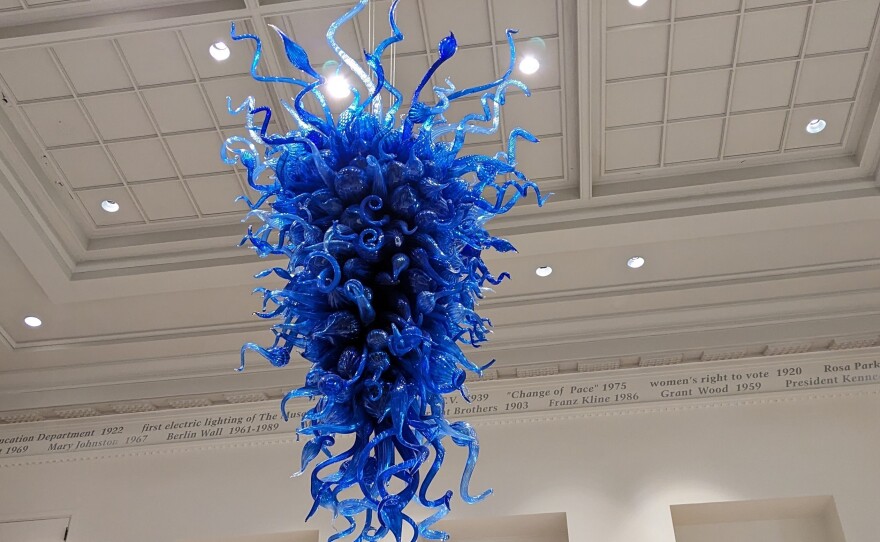You may have wondered about the backstory of a local landmark, or pondered how a tradition came to be. That's where our feature OKI Wanna Know comes in: digging into local oddities. This week, WVXU's Bill Rinehart examines a fragile-looking chandelier.
Right inside the front doors of the Cincinnati Art Museum, hanging over the welcome desk, there's a glob of blue glass. Squiggly tails jut out in varying shades of blue. It's called the Rio delle Torreselle chandelier, and it was created by Dale Chihuly in 1995.
The installation caught the eye of Phil Armstrong of Bellevue.
"It's been there for years," he says. "I'm really curious about how they installed this incredibly beautiful yet fragile, massive work of art from the ceiling."
The director of exhibitions for Chihuly Studio in Seattle says the piece was made specifically for a display in Italy. Britt Cornett says Dale Chihuly woke up one day and decided to create some art for Venice.
"He took his team to different glass-making facilities around the world to create the work that would ultimately be mounted over the canals and piazzas in Venice," Cornett says. "The thing to keep in mind is that this is something he did by his own initiative."
The glass for the Rio delle Torreselle chandelier was blown in Finland. Each form you see is an individual piece.
RELATED: What's on the ceiling of Music Hall's Springer Auditorium?
According to the Cincinnati Art Museum, in 1998, the then-director of curatorial affairs and curator of decorative arts, Anita Ellis, saw the piece on display in Columbus. It was purchased with donor funds and installed at the museum in 2001. Cornett says the piece is complicated.
"Each hand-blown form then is mounted to a steel armature that is designed and fabricated here at the studio. We build the work full-scale at the studio. In this case, it started out in Venice, and then it was prepared for the museum," she says. "It's all shipped to the museum, and put together piece by piece on-site."
Each piece is individually tied to the framework. Chuhily has other pieces on display — indoors and outdoors — around the world. Cornett says there's a lot of engineering involved each time.
"There's back and forth conversation between the studio and the museum, or the organization, that leads to documentation of the actual connection points where the piece is hung," she says. "Ultimately then the use of lifts to get something like that up in the air, and then a team from Chihuly Studio actually building the work on-site, piece by piece."
Every now and then, the chandelier needs to be cleaned. Kelly Rectenwald is the objects conservator at the Cincinnati Art Museum.

"It's sometimes difficult to see from down here, but all of the glass pieces — it's ridged. They're not all smooth. They have these little ribs in them, and those collect dust and change how the light reflects off of it," she says. "So it does look much different when it's cleaned."
Rectenwald says it's not an easy task. Not only is it glass, it's also suspended above the museum's welcome desk.
"So if you touch it from one side, it will move. And sway. You need to have a balanced approach, where you approach it from two sides, with the same amount of pressure," Rectenwald says. "We have four lifts that go up at the same time. And we have four people working from each of the sides at the same time. We start at the top. We work with Swiffers, and go all the way down."
In case you're hoping to watch the process, the chandelier is typically cleaned when the museum is closed for the day.
So, what is the chandelier? What does it represent? Britt Cornett says it depends.
RELATED: Why was there a rooster on a light pole in downtown Cincinnati?
"Well, you know, it's art. It's up to people's interpretation. But there's not a one-to-one correlation or something that he's mimicking with the art that he's made for 60 years now. It inspires something different for different people," Cornett says. "It's really about the massing of color, and use of the form that the forms that are hand-blown and mounting them in such a way they're all externally lit. So it's really about form, color and the environment in which it lives."
The Cincinnati Art Museum is open Tuesday through Sunday, from 11 a.m. to 5 p.m. General admission, including to see the Chihuly chandelier, is free.
Have a weird, nagging question you'd like answered? Submit it using the form below and we may answer it.



